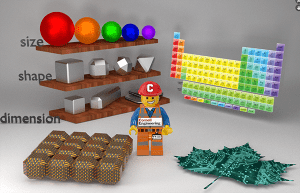Access to nanostructured building blocks with programmable size, shape, and composition has opened up a rich and exciting opportunity space to create novel materials and technologies. Our work in this area is driven by imagining what will be possible in 10, 20 years and beyond. Specifically, if we can apply this control over structure and composition from nano-to-macroscales to engineer interfacial processes such as charge transport and surface reactions. Beyond the scientific curiosity driving our work in this field, we are inspired by the vision that advances in our understanding of and control over these processes provide the foundation for anticipated energy-related applications including photovoltaics, LEDs, and catalytic reactors.
One grand challenge to bring the acclaimed prospects of nanomaterial enabled technologies to fruition is to arrange the nanoscale components into higher order structures in which individual elements can interact in purposeful and programmable ways. We are particularly interested in the self-assembly of superlattices in which constituent quantum dot (QD) building blocks are not only precisely positioned but also oriented relative to each other. This type of ‘crystal-of-crystals’ – also known as a mesocrystal – is a unique type of metamaterial whose emergent properties are governed by the interplay of quantum confinement of individual QDs and quantum coupling between them.
Creating these materials presents several interesting challenges. In many ways, our endeavors to create materials and devices from QD building blocks are similar to kids playing with LEGOs. Unlike LEGOs however, our structures have to be formed ‘hands off’ and instead rely the physical and chemical interactions driving the molecular scale self-assembly. To become QD mesocrystal ‘master builders’ we therefore need to understand the thermodynamic and kinetic aspects at play to direct how the QD blocks assemble and connect with each other.
Fluid interfaces provide a versatile and advantageous processing platform to create and study nanomaterial assemblies. In the specific case of QD mesocrystals, the interface between two immiscible fluids provides a convenient ‘reactive workbench’ to direct the initial assembly and subsequent epitaxial attachment of QD building blocks. Our previous investigations of the fundamental mechanism underlying the complex choreography of self-assembly, structure transformation, and oriented attachment have established a firm foundation for the formation of epitaxially connected mesocrystals. Building on the foundation of this mechanistic understanding, we see compelling prospects to extend this approach towards more complex structures. For example, the intricate structural hierarchies common to many systems in nature provides strong inspiration and guidance for future advances in this field. We see the interfacial assembly processes as a promising first step towards advancing layer-by-layer additive manufacturing processes that enable the creation of more complex, multi-component hierarchical structures. These fundamental assembly studies therefore have strong synergies with concurrent research ambitions to create hierarchical superstructures. We are excited about the emerging opportunities at the intersection of bottom-up self assembly and additive manufacturing techniques and the implications of these advances for our concurrent studies in electrocatalysis and integration of nanomaterials and biological systems.

